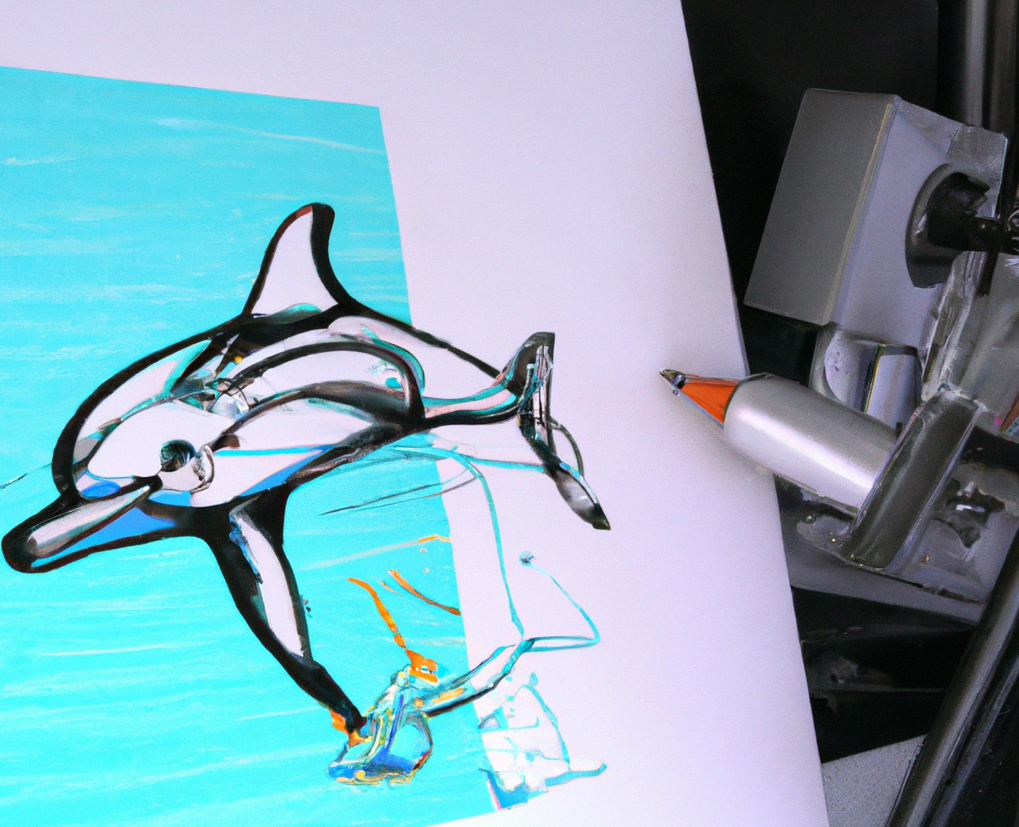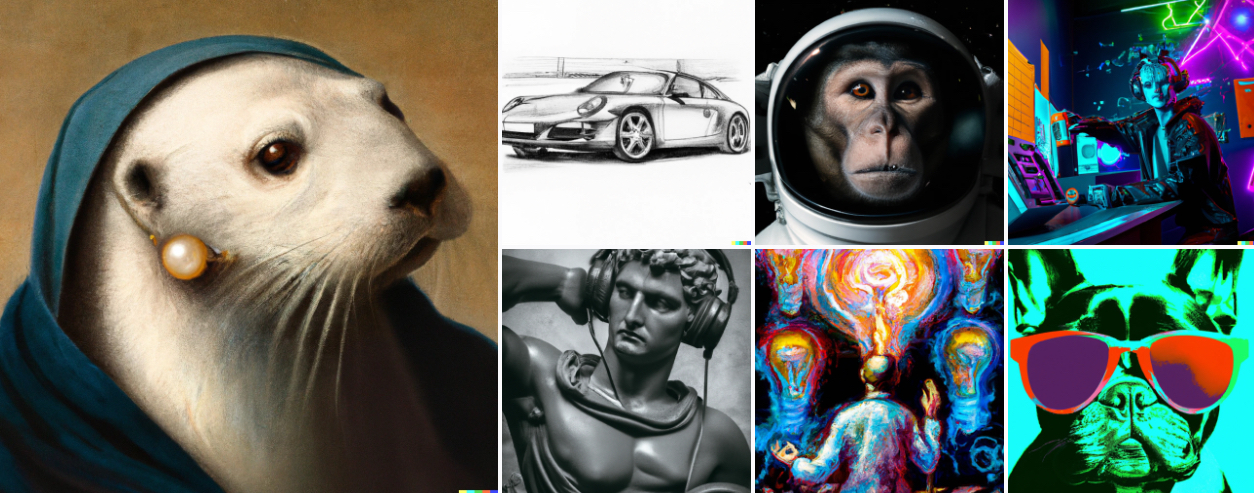What is AI art?
Generative AI can take human prompts and produce an output. This typically takes the form of text input that generates an image based on the context of the input. And the generated images are often astonishing. Not only that, but these AI tools can generate variations of images based on the style of a supplied image. It can even copy an artist’s style, without copying any of their artwork, just by putting the artist’s name in the prompt, for example, A horse standing in a field by a barn in the style of Turner. Parts of an image can also seamlessly be replaced with another image using a process called in-painting.
Some of the most talked about AI artist tools are:
DALLE-2 from Open AI
Midjourney from Midjourney
Imagen from Google
Disco diffusion Open Source
For the rest of this post, we’ll focus on DALLE-2, mainly because that’s the one getting the most attention right now. Let’s look at an example.
I asked DALLE-2 for A robot painting a picture of a dolphin in the style of Andy Warhol in an artist’s studio lit by natural light and here’s what it gave me.

How does DALLE-2 work?
The Explain it like I’m 5 (ELI5) version would go something like this:
DALLE-2 takes some text you type in, called a prompt, works out what it means and then uses some clever maths to produce a picture. When DALLE-2 was built, it was shown millions of pictures with words describing what was in the pictures. Once DALLE-2 knows what the prompt means, it looks at all the pictures it knows about and tries to predict how closely the text descriptions of the pictures are like the prompt. And once it understands which parts of the pictures it knows about relate which parts of the prompt, it can generate a brand-new picture, not by copying parts of the pictures it already knows about, but using an interesting way of generating a picture from a jumbled mess of random pixels guided by its understanding of the prompt and pictures it knows about.
For a more thorough, technical overview of how it works, there are some excellent articles here, here and here.
What does this mean for artists who make a living from their creations, and will this new tool devalue their art?
How are artists reacting to AI Art?
Artists appear to have two distinct reactions; Do I still have a livelihood?, or How can I use this new art form to my advantage? Particularly concerning to some artists is the ability for AI art tools to copy an artist’s style. Artists spend years training to hone their style, and if anyone who can form a sentence is able to create high-quality art in a myriad of styles, how can artists retain their unique style and express their individuality?
For the artists embracing the new technology, they’re exploring the idea the idea of prompt craft - creatively crafting the text prompt to generate art that is unique to the creator of the prompt. Artist James Gurney believes that consumers of AI-generated art should be able to see the text prompt used to generate the artwork and professional artists should be able to opt out of their artwork used in the training set.
Open AI, whose mission is bring beneficial AI to the world, promotes DALLE-2 system as:
DALLE-2 is an example of how imaginative humans and clever systems can work together to make new things, amplifying our creative potential.
Many of the AI art tools are rolling out invitation-only beta access. The public appetite is insatiable and social media is awash with their creations. The dalle2 subredit has some highly creative examples of generated images and spectacular animated images that have been stitched together, like this example from Reddit user JackTheTak.
What about copyright? Who is the creator and who is the owner of the copyright of AI-generated art? Should artists be credited and compensated when AI art is generated based on their style? Questions like these remain answered as the AI tools gain popularity and their influence spreads. A recent UK government consultation on AI and copyright concluded that the status quo should be observed for now.
There will be an immediate impact on certain industries. The stock photography and illustration industries will change forever. The current mainstream AI tools make it easy to generate photorealistic images for use in documents and videos. The revenue previously generated by the large stock photo agencies will be distributed among the AI tools that will increasingly offer subscription services. Although it’s also likely that stock photo agencies will begin to offer an AI-generation service for their customers who are loyal to their brand.
History repeats
The Camera Obscura was used by artists in the 16th century as a painting aid. A small hole let light into a dark room, revealing an upside-down image that could be used as a reference, and even traced. Many artists saw this as cheating, but in reality, artists were adapting to newly available tools and techniques. As the camera obscura became more portable, and with the advances in photographic printing resulting in the first printed photograph in 1825, the new art form of photography was born.

The hot questions at the time were Are portrait painters going to be put out of business? and Is taking taking a photograph really creative? Taking a picture involved little effort, was almost instantaneous, and was just capturing the image in front of the camera. As it turned out, there was considerable creativity afforded to photographers when composing the image, choosing different lenses, filters and hand-crafting the resulting prints to introduce effects not present in the original scene. The mass production of cameras in the 50s democratised creativity for many people. This is a common theme of technological progress.

The world of musical instruments has taken a similar path. From purely acoustic instruments to electric instruments that could be amplified, to simulations of instruments, sampled instruments and ever more portable studio-quality production software. Now musicians can record, mix and produce music on a laptop without having to own, or even be able to play the instruments well. Is this cheating, or again, is this democratisation of a new art form? Experienced and skilled musicians still stand out from amateurs, but the barrier to entry was lowered.
As we look towards the advances in AI-generated art, we see a similar pattern. As we’ve seen, it’s now possible to create high-quality, original art with just a sentence describing what you want to see and the style you’d like it in.
What’s next for AI generative tools?
AI generative tools are already encroaching into other areas. In 2020, Open AI introduced GPT-3, a language generator which can generate human-like text output from a text prompt. In UK, The Guardian newspaper used GTP-3 to write an essay to convince the reader that robots some in peace. In the world of coding, the partnership between The partnership between Open AI and Microsoft produced GitHub Co-Pilot, based on Open AI’s Codex project and described as Your AI programmer. GitHub Co-Pilot can extract information from a text prompt and can write small sections of code in various coding languages. Is this cheating or just a tool? It has certainly divided programmers.
AI art will continue evolve at pace. And in its sights are moving images and entire movies built with AI-generated content. Education could be transformed using AI-generated content, bringing history and science to life with the help of Extended Reality (XR) peripherals. Personalised learning could become the poster child for beneficial AI.
Will humans lose creative ground to machines in the digital domain? It’s likely it will be similar to the birth of the camera. AI generation will become a tool that makes it easier for anyone to be creative without needing the training, skill, or knowledge. New art forms will appear, and artists will adapt by embracing the technology to combine with other art forms, or work exclusively in areas untouched by AI, such as physical art, or performance art. Will there ever creative pursuits that will be out of reach of machine? No. The machines are coming.
